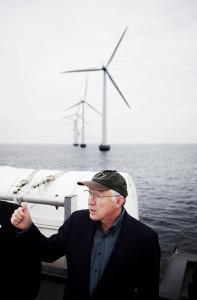We have much more to do and your continued support is needed now more than ever.
Climate Plan Sets the Stage for Offshore Wind Power’s American Debut

In a much-anticipated pledge to address the dangerous levels of carbon emissions people and wildlife are increasingly subjected to, he laid the beginnings of a road map to cleaner air and cleaner water, sustainable job growth, responsible economics, and global leadership. Obama’s plan draws important conversations forward to the public stage, and creates welcome space for the clean energy innovation and development we are so ready for—and so desperately need.
During his speech, the president called for all hands on deck, and emphasized the great progress that can and will come from recognizing our own potential as a nation:
“We’ll need scientists to design new fuels, and we’ll need farmers to grow new fuels. We’ll need engineers to devise new technologies, and we’ll need businesses to make and sell those technologies. We’ll need workers to operate assembly lines that hum with high-tech, zero-carbon components, but we’ll also need builders to hammer into place the foundations for a new clean energy era.”
A New Clean Energy Era

I attended a presentation in Baltimore last week and got a taste of this inspiration. A few members of Maryland’s state government recently traveled to Denmark and Germany to learn about Europe’s booming wind energy industry. The Maryland officials reported on just how impressed they were with what they saw, and their full audience was visibly intrigued. These projects are enormous undertakings and they wear high up-front price tags. But the size of the task pales in comparison to the size of the reward:
- We need clean energy and we have an unlimited supply;
- we need to know how to harness and transmit this energy and we have the technology to do so;
- we need to create jobs and wind turbines will always need to be produced, installed, operated, and maintained;
- and as we move to leave behind the burning of fossil fuels, offshore wind power offers a clean and renewable alternative for meeting our energy needs.
Not to mention—in case that isn’t enough—in Obama’s speech on Tuesday he promised to encourage investment in clean energy and called on Congress to support the right industries:
“And because billions of your tax dollars continue to still subsidize some of the most profitable corporations in the history of the world, my budget once again calls for Congress to end the tax breaks for big oil companies and invest in the clean energy companies that will fuel our future.”
The United States is in a very exciting position. Not only do we have an immense wealth of wind energy blowing off our shores—we also have two decades of European innovation to tap into. For twenty years, and through the development of 55 projects, Europe’s wind industry has improved technology, tested various investment strategies, and learned from mistakes. And we get to benefit from all of it. This is a tried-and-true, advanced answer to the challenge of fueling the lives we lead today, without endangering the ability of future generations to do the same.
So what are we waiting for?
No matter how clear the case is for responsibly-sited offshore wind development, it’s new to us here in the U.S., and new can be hard. On Block Island for example—home to a small community off the coast of Rhode Island, and a popular destination for sailors and beach-goers—residents are years into a discussion surrounding whether they want their home to be one of the nation’s first models to adopt this new resource. Block Island’s water and wind profile make for a picture perfect offshore wind candidacy. The proposal under consideration is for five turbines, three miles off the island’s southeast shore, that will meet all of the island’s energy needs and send the excess power to the mainland.

For those still unconvinced, the offshore wind proposal wins greater local support with sheer numbers. Block Island residents and business owners pay among the very highest electricity rates in the country. Switching to offshore wind power will cut these exorbitant energy bills in half. Plentiful, cheap and clean electricity offers the ability to run air conditioners that hotels cannot currently afford to run, and opens doorways of opportunity to explore a shift to electric vehicles to help free locals from the burden of the island’s also very high gas prices.
Yes, these turbines will alter a small stretch of a historic view from the island. But they will also write Block Island into a new history, one that will determine what kind of future we pursue for our children and the generations that follow. President Obama’s announcement painted the big picture, and it’s leaders like those in Maryland and on Block Island that will determine the quality of the details. The communities that embrace the challenge of the new will get to own as their legacy bold leadership at a critical turning point—hopefully for a very long time, on a very healthy planet.





















